|
|
|
All of the images (plus lots more) were created on a very short visit at the end of January. Click on the card to enjoy a larger version. Merritt Island NWR IPT card |
Merritt Island NWR IPT
Merritt Island NWR IPT. 3 1/2 DAYS. MON 15 MAR thru the morning session on THURS 18 MAR 2021. $1499 includes three lunches. Limit: 6. Openings: 4.
When I visited — and later lived — in Deltona, FL, I made many trips to Black Point Wildlife Drive and environs. On a recent visit, I did quite well. The birds were much tamer than I remembered. I know the place well. Early spring was always best. There are tons of ducks, and wading birds including and especially both ibises. It can be great at sunrise with large flocks of shorebirds, waterfowl, ibises, and American White Pelicans filling the skies. We should get to do lots of flight photography on the causeway. At least a few good chances with Roseate Spoonbill are possible.
A $499 deposit is required to hold your spot for this IPT. You can send a check (made out to “BIRDS AS ART) to us here: BIRDS AS ART, PO Box 7245, Indian Lake Estates, FL, 3385, or call Jim or Jennifer at the office with a credit card at 863-692-0906. Your balance, payable only by check, is due immediately after you sign up. If you have any questions, please feel free to contact me via e-mail. If you cancel due to COVID 19 concerns, all of your payments will be refunded.
This Just In!
At 11:15am on Sunday 21 February, I completed work on the first draft of all Menu items for the R5 Camera User’s e-Guide. Don’t get too, too excited; there is still lots of work to do.
What’s Up?
After struggling to finish yesterday’s blog post ASAP and head over to Lakeland, I did manage to get on the road at 6:44am. It was totally cloudy when I left. The sun broke through the clouds for a while. Once I got set up, the clouds predominated though the light kept changing. It was great to see that the pelicans were back in force; thanks to BPN-friend Joe Przybyla for the heads-up.
I did get some work done on the R5 User’s Guide yesterday, enjoyed my swim, and headed down to the lake for a half-way decent sunset, the first in more than a week. With the wind from the northeast, conditions were perfect but they were not landing in the perfect spot …
I was glad to learn that two many-multiple IPT veterans, Donna Bourdon and John Dupps, signed up for the Merritt Island NWR IPT. And good friend Bill Schneider will be joining me for two private days after the IPT ends. He wants to learn how to set up his Sony Alpha a1. We should be getting our new bodies in early March.
Folks who would like to explore the possibility of an In-the-Field Instructional Session in Lakeland (two hours/$200) are invited to contact me via e-mail to consider the weather and set up a date.
As always, questions and comments on today’s images are welcome.
Today is Sunday 21 February 2021. The forecast for partly sunny turning cloudy early with easterly winds. Things are looking pretty good for my morning photo session. After two chilly days in a row, the pool is down six degrees …
This post took about 2 1/2 hours to prepare and makes sixty-three days in a row with a new one. Please remember …
Please Remember
With income from IPTs now at zero, please, if you enjoy and learn from the blog, remember to use one of my two affiliate programs when purchasing new gear. Doing so just might make it possible for me to avoid having to try to get a job as a Walmart greeter and will not cost you a single penny more. And if you use Bedfords and remember to enter the BIRDSASART code at checkout, you will save 3% on every order and enjoy free second-day air shipping. In these crazy times — I am out at least forty to sixty thousand dollars so far due to COVID 19 (with lots more to come) — remembering to use my B&H link or to shop at Bedfords will help me out a ton and be greatly appreciated. Overseas folks who cannot order from the US because of import fees, duties, and taxes, are invited to help out by clicking here to leave a blog thank you gift if they see fit.
Canon R5/R6 AF e-Guide Info
So far, more than 122 folks have sent PayPals for their copy of the Canon R5/R6 AF e-Guide. And 41 who used my affiliate links to purchase their Canon mirrorless gear have e-mailed for and received their free copy of the guide. If you e-mailed your Bedford receipt or sent a PayPal and did not receive your guide, please LMK immediately via e-mail.
Feedback on the guide continues to be overwhelmingly positive. Please scroll down to read about the BAA Canon EOS R5/R6 User’s e-Guide. Note that the info in the BAA Canon R5/R6 Autofocus e-Guide is so important that I opted to publish the AF guide immediately as the R5/R6 User’s Guide will still take about another week or two to complete.
|
|
BAA Canon R5/R6 Autofocus e-Guide |
The Canon R5/R6 Autofocus e-Guide is Now Complete!
Forty-one pages. 6250 words. 50-DPP4 screen captures showing the R5’s vaunted AF system in action. Note: the AF system of the R5 is identical to the AF system of the R6.
You will learn:
1- The two most useful AF Methods for general bird photography and for birds in flight and the one AF method that works best for me for birds in flight.
2- How to set up your R5/R6 AF Menus.
3- What boxes to check (and un-check) under Limit AF Methods.
4- How to change the AF Method quickly, easily, and efficiently. Note: the default way of doing this is clunky, cumbersome, and inefficient at best. One person replied that this tip alone was worth the price of admission.
5- The only setting that should be used for Initial Servo AF pt for Face Detection + Tracking.
I you are currently using multiple back buttons either for general bird photography or for birds in flight, what you learn in this guide will change your life. For the better.
The guide is free to all who have ordered an R5 or an R6 using my B&H affiliate link or from Steve Elkins/Bedfords using the BIRDSASART coupon code at checkout. Please send your receipt to me via e-mail. It will take me a few days to a week to verify the B&H purchases. Bedfords folks should expect their free e-Guides fairly quickly.
To purchase your copy of the e-Guide, please click here or send a PayPal for $25.00 to birdsasart@verizon.net and be sure to include the words R5/R6 AF Guide in your PayPal e-mail.
Everyone who purchased the AF guide will receive their free update some time today.
Canon EOS R5 Camera User’s e-Guide
As most of you know, I have been working on a complete BAA Canon EOS R5 Camera User’s e-Guide. Because the camera and the Menus are so complex, this has required a lot of research, a lot of time, and a lot of effort (and will continue to do so until it is complete). It should be finished by late February. The final update of the R5/R6 AF e-guide has become part of the complete Camera User’s e-Guide; it will be revised if warranted.
The complete Camera User’s guide will sell for $75.00. Folks who purchased their Canon gear using my links will receive a $65.00 discount; the guide will cost them a nominal $10.00. Folks who spent more than $7500.00 on Canon mirrorless gear using either of my affiliate links (B&H or Bedfords), will receive the User’s Guide for free. Folks who purchased the R5/R6 AF e-Guide will receive a $10.00 discount on the User’s e-Guide. The best news is that the end is in sight.
Great Topaz News!
Folks who use the BAA Topaz link to purchase Sharpen AI, DeNoise AI, or the Utility Bundle (or any other Topaz plug-ins) will receive a 15% discount by entering the ARTHUR15 code at checkout. If the stuff is on sale (as it usually is), you save 15% off of the sale price! To get the discount you must use my link and you must enter the discount code. Be sure to start with this link.
Those who purchase Sharpen AI, DeNoise AI, or any other Topaz plug-ins using my link and then entering the ARTHUR15 code at checkout can e-mail to request a short Getting Started with Topaz e-Guide. Please include a copy of your Topaz receipt that shows the discount. Aside from the basics, the guide explains how to install the plug-ins so that they appear in the Photoshop Filter Menu.
New and Better Bedfords Discount Policy!
You can now save 3% on all of your Bedfords photo gear purchases by entering the BIRDSASART coupon code at checkout. Your discount will be applied to your pre-tax total. In addition, by using the code you will get 2nd day air shipping via Fed Ex.
Grab a Nikon AF-S Teleconverter TC-14E III and save $14.99. Purchase a Canon EOS R5 and your discount will be $116.97. Purchase a Sony FE 600mm f/4 GM OSS lens and save a remarkable $389.94! Your Bedford’s purchase no longer needs to be greater than $1,000.00 for you to receive a discount. The more you spend, the more you save.
Money Saving Reminder
Many have learned that if you need a hot photo item that is out of stock at B&H and would enjoy free second-day air shipping, your best bet is to click here, place an order with Bedfords, and enter the coupon code BIRDSASART at checkout. If an item is out of stock, contact Steve Elkins via e-mail or on his cell phone at (479) 381-2592 (Central time). Be sure to mention the BIRDSASART coupon code and use it for your online order to save 3% and enjoy free 2nd-day air shipping. Steve has been great at getting folks the hot items that are out of stock at B&H and everywhere else. The wait lists at the big stores can be a year or longer for the hard to get items. Steve will surely get you your gear long before that. For the past year, he has been helping BAA Blog folks get their hands on items like the SONY a9 ii, the SONY 200-600 G OSS lens, the Canon EOS R5, the Canon RF 100-500mm lens, and the Nikon 500mm PF. Steve is personable, helpful, and eager to please.


Gear Questions and Advice
Too many folks attending BAA IPTs (remember those?) and dozens of photographers whom I see in the field and on BPN, are–out of ignorance–using the wrong gear especially when it comes to tripods and more especially, tripod heads… Please know that I am always glad to answer your gear questions via e-mail. Those questions might deal with systems, camera bodies, accessories, and/or lens choices and decisions.
|
|
|
This image was created on 20 February 2021 at my favorite morning spot in Lakeland, FL. I used the Induro GIT 404L/Levered-clamp FlexShooter Pro-mounted Sony FE 600mm f/4 GM OSS lens, the Sony FE 2.0x Teleconverter, and the blazingly fast AF King, the Sony Alpha a9 II Mirrorless Digital camera body). ISO 800. The exposure was determined by Zebras with ISO on the rear wheel: 1/500 sec. at f/8 (wide open) in Manual mode. RawDigger showed this exposure as 1/3-stop too dark. AWB at 8:12am. Tracking Expand Flexible Spot AF-C was active at the moment of exposure and performed to perfection. Click on the image to enjoy a larger version. Image #1: American White Pelican face detail |
Two-system Insanity Success
I got out of my car, set up the SONY 600 GM on the Induro 404L tripod with the 1.4X TC and the a9 ii. Then I screwed the Black Rapid Curve Breathe strap connector into the bottom of the camera body (with the RF 100-500 mounted on it) and put the Canon rig on my shoulder. The Canon rig is so light that you barely know that it is there. Once it got a bit brighter, I replaced the 1.4X TC with the 2X.
Note the time of creation for each image; amazingly, all of those that I chose for today’s blog were made in just six minutes.
|
|
Image #1A: Topaz DeNoise AI with the American White Pelican face detail image |
Low Light Continues to Shine
Here again, starting in Comparison View, Low Light on Auto was the clear but narrow choice over DeNoise AI on Auto. Click on the image to see the incredible image quality of the SONY a9 ii 1200mm images and the complete elimination of the noise in the background.
Saved by my Own Guide!
I recently updated Photoshop to Adobe Photoshop 2021 22.2.0 Release to try some new features. The update did save all of my keyboard shortcuts and my actions, but I lost Topaz. And I did not know how to get Topaz to re-appear in the drop-down menu under Filter. So I opened a copy of the Topaz Getting Started Guide, followed the directions, and was good-to-go in three minutes. Hooray! You can get your free copy of this e-Guide by using the ARTHUR15 code at checkout.
|
|
|
This image was created on 20 February 2021 at my favorite morning spot in Lakeland, FL. I used the handheld Canon RF 100-500mm f/4.5-7.1L IS USM lens (at 500mm) and the highly touted 45MP Canon EOS R5 Mirrorless Digital camera body. ISO 1250. Exposure determined via test image/histogram evaluation: 1/2000 sec. at f/7.1 (wide open) in Manual mode. RawDigger showed this one to be 2/3 stop under-exposed. I still struggle at times with R5 exposure). AWB at 8:14am on a then cloudy morning. The very best R5/R6 AF Method for birds in flight (IMHO) is detailed in the R5/R6 AF e-Guide. Image #2: American White Pelican in flat flight |
Working with Two Rigs
I am photographing the pelicans on the bulkhead at 1200mm. I see two pelicans flying over the lake. I step out from behind the tripod and move to my left, raise the 100-500, make sure that it is zoomed to 500mm, adjust the exposure as best I can, and fire off a few frames. With sharp R5 45MP files, large crops (like the one here) are no problems. Once the birds fly off, I get behind the tripod and go back to work with the SONY gear.
|
|
|
This image was created on 20 February 2021 at my favorite morning spot in Lakeland, FL. I used the Induro GIT 404L/Levered-clamp FlexShooter Pro-mounted Sony FE 600mm f/4 GM OSS lens, the Sony FE 2.0x Teleconverter, and the blazingly fast AF King, the Sony Alpha a9 II Mirrorless Digital camera body). ISO 640. The exposure was determined by Zebras with ISO on the rear wheel: 1/500 sec. at f/9 (stopped down 1/3-stop) in Manual mode. RawDigger showed this exposure as 1/3 stop too dark. AWB at 8:16am. Tracking Expand Flexible Spot AF-C was active at the moment of exposure and performed to perfection. Click on the image to enjoy a larger version. Image #3: American White Pelican face and bill detail |
Working at 1200mm with the SONY Gear
When I noticed the yellow reflections on the water behind the last pelican on my in line-up, I had to move the tripod to my left and back up a bit to be able to include the horn on the pelican’s bill in the image. It was faster and easier to do that than to switch out the 2X for the 1.4X TC. With the remarkable sharpness of the SONY rig at 1200mm, image quality is never an issue when deciding between 840 and 1200.
|
|
|
This image was created on 20 February 2021 at my favorite morning spot in Lakeland, FL. I used the handheld Canon RF 100-500mm f/4.5-7.1L IS USM lens (at 500mm) and the highly touted 45MP Canon EOS R5 Mirrorless Digital camera body. ISO 1000. Exposure determined via test image/histogram evaluation: 1/2000 sec. at f/7.1 (wide open) in Manual mode. RawDigger showed this one to be 2/3 stop under-exposed. I till struggle at time with R5 exposure). AWB at 8:18am on a then cloudy morning. Face detection + Tracking performed perfectly by nailing and tracking the bird’s eye. Learn to quickly and easily change R5/R6 AF methods in the R5/R6 AF e-Guide. Image #4: American White Pelican swimming |
Sometimes Loving What Is is a Better Choice than Bitching and Whining
When the guy emptying the trash receptacles around the lake drove by on his 4-wheel ATV, several pelicans slid into the water and began swimming away. Rather than getting pissed off, I made the best of the situation by moving well to my left (away from the tripod) and created this image. I just love the dark water.
Typos
In all blog posts and Bulletins, feel free to e-mail or to leave a comment regarding any typos or errors.

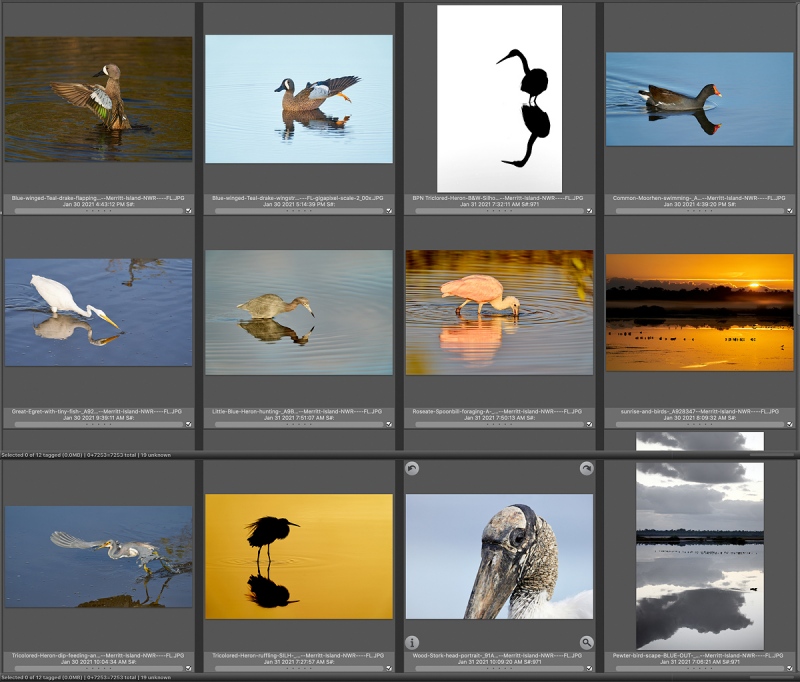
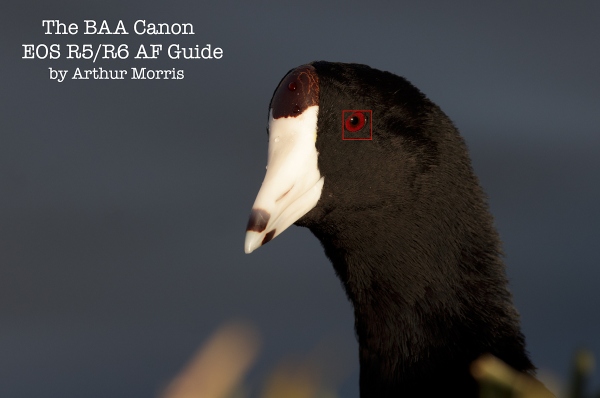

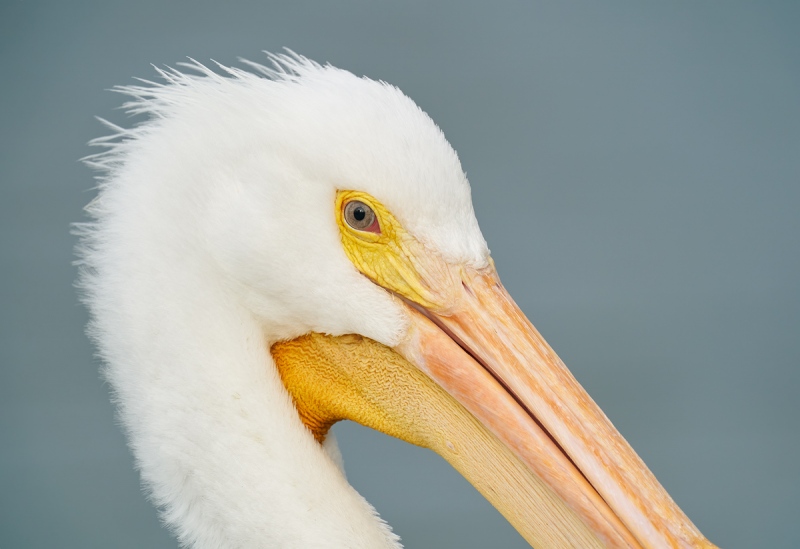
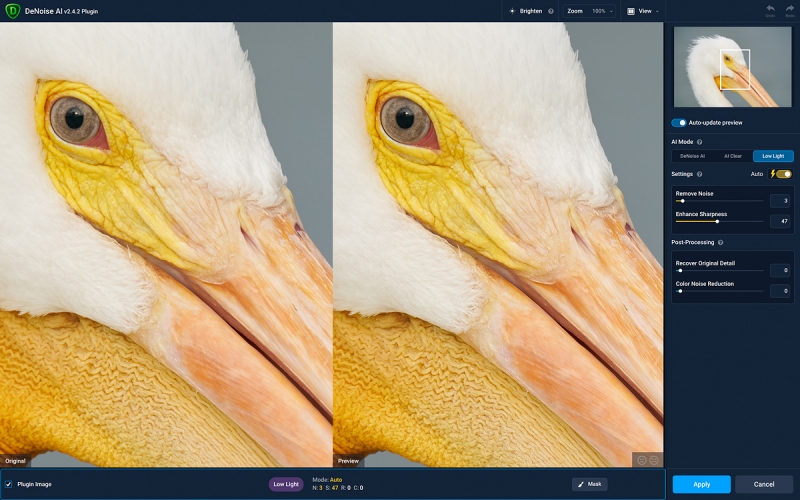
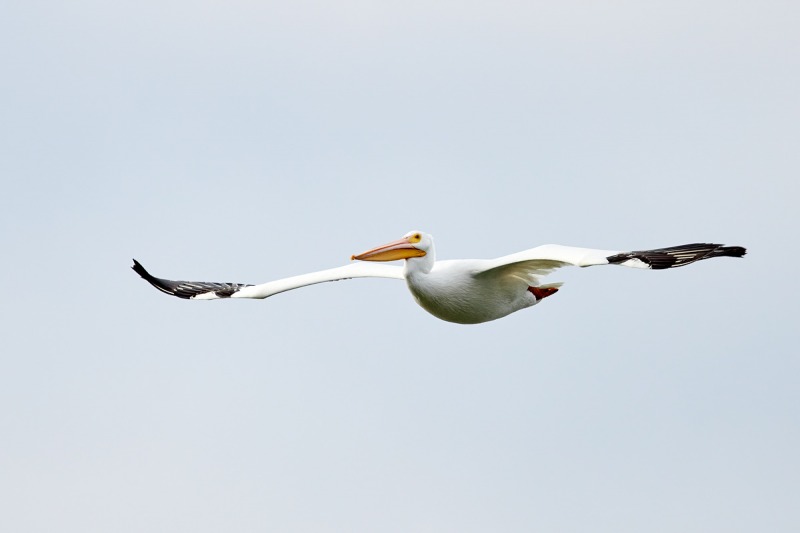
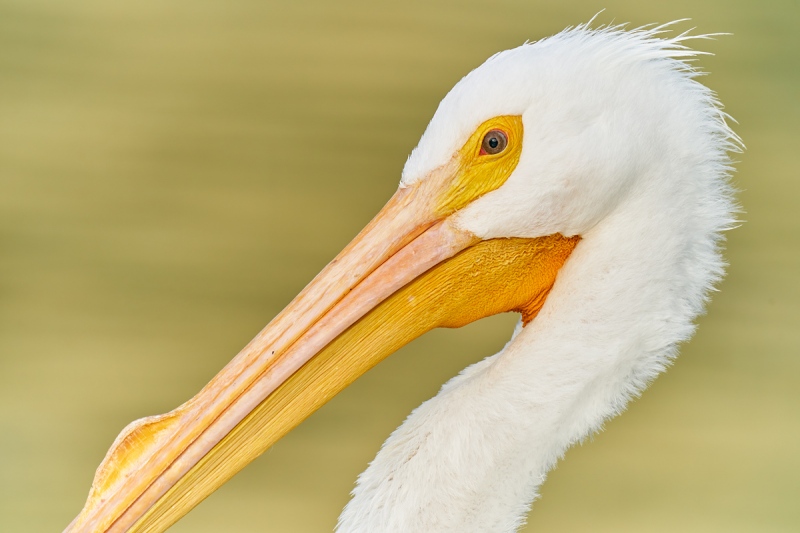
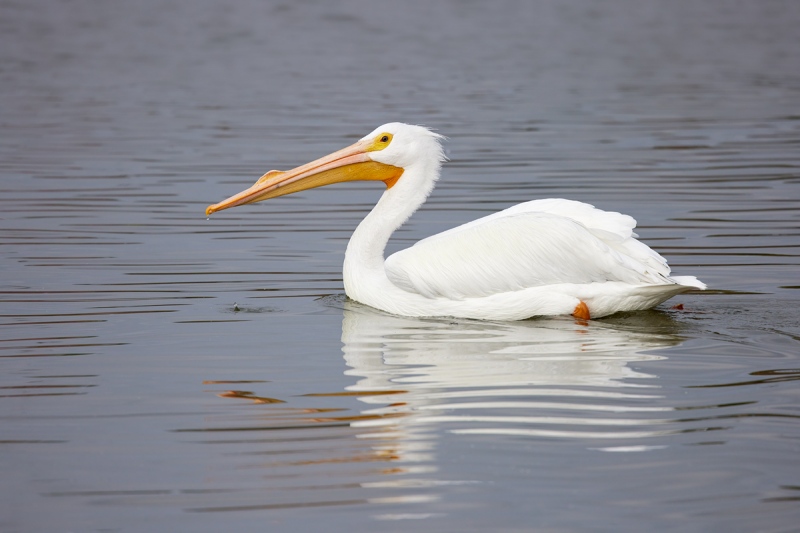










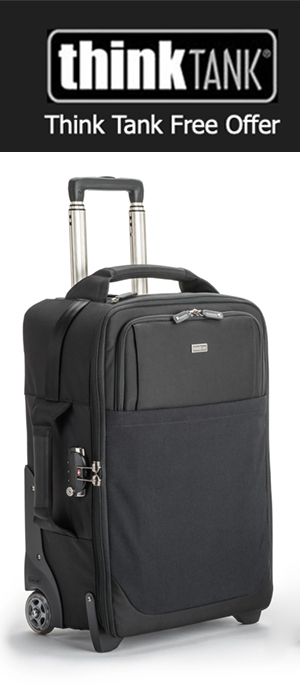


I prefer image #3 — the background color looks great with the white pelican.
Howdy Artie
Image #3 for me and backing up to include the horn made this as it draws my eye but the whole image draws my eye the softness of the white on the neck look fluffy or could it be the birthday winds….lol sorry David had to.
I need a lifetime to learn everything you talk about as it took your life to learn. Again amazing image #3 and at 1200mm way to go Sony and the Guru behind the camera!
With love b
Hi, Artie. Wouldn’t a birthday wind at sunset be bad for flight photography? I prefer southwest or west. Northeast at sunrise. My favorite is image # 3.
I thought I had typed northeast wind, where did birthday come from?
Birthday, northeast, it’s all the same to me 🙂
Remember that when I go down to the lake near sunset, I am always trying to create silhouettes; a good wind for traditional bird photography is a bad wind for silhouette shooting. When I am looking at the sun and the brightly colored sky I want the wind behind me so the birds will be flying and landing toward me.
That is why when there were such things as crane pools at Bosque the best wind for sunset silhouettes was a northeast wind …
You lose two points here only because this has been mentioned before many times 🙂
with love, a
I accept my punishment, Artie. I had mistakenly thought you did silhouettes as a way of making lemonade from lemons when wind was against sun. Dr
When I look at the improvements in sharpness and noise yielded by the Topaz software, I wonder why the camera manufacturers don’t just build that capability into their cameras. Why is third-party software, and lots of extra time and work, required to get the best out of the hardware they make?
You will have to ask them 🙂
with love, a
I lost NIK in my filter menu. Still have it as a standalone but can’t get an image into it. Maybe your Topaz Getting Started Guide will get NIK back too.
Perhaps. I am pretty sure that the process is similar. That said, when I updated Photoshop my NIK stuff survived intact and appeared in the drop-down menu under Filter.
with love, a
I am surprised the flying pelican was under exposed. The white in the wings looks almost blown out. I know I’m not looking at a histogram or detailed data from raw digger or the raw image, but that looks like a pretty maxed out exposure. The question is: did you have to brighten the image in post?
I like the 3rd image the best with the beautiful Golden water background. Backgrounds make the image, right!
Thanks for everything.
Hi Warren,
Thanks for your comment. First off, realize that the way an image looks after being processed has zero to do with the raw file exposure (or brightness). Second, viewing conditions in terms ambient light vary for most everyone. And even color-calibrated monitors will vary tremendously as far as color and brightness. Last, as stated here often, white feathers in images created in soft light will rarely show and fine-feather details.
Here I wanted to make the bird as bright as possible in an attempt to give this cloudy-day image some pop. The RGB values on the brightest WHITEs on the upper wings are all in the low 250s. While not technically over-exposed that is brighter than I usually go so you do have a valid point.
with love, artie